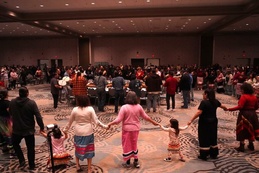The Cost of Things: Embodied Energy Offers a Truer Picture of the Environmental & Social Costs of Consumption
April 7, 2004
Energy is a big theme these days. We hear about coal energy, wasting energy, conserving energy, renewable energy, and some of us even eat energy bars. But did you know we can use energy as a means of assessing the value of everyday objects?The dollar amount affixed to goods and services is driven by the market; however, a full reckoning should include all the energies embodied in an item. For example, the gasoline that goes in your car may cost you about $1.80 per gallon, but this price only includes the labor to drill oil, the price of building and maintaining refineries, and the delivery system -– all from the perspective of the oil company.
What doesn’t go into that purchase price are the costs associated with things like your daughter’s asthma, the loss of your favorite natural area, or the taxes you pay so the government can provide subsidies for resource extraction and transportation. This omission sends a false message to the market. It leads us to believe that the pollution of our air, water, and soil is essentially without cost and that nonrenewable resources are inexpensive.
EMBODIED ENERGY
Instead of using only the dollar as a unit of measure, many people are turning toward the concept of embodied energy. Local builder group Burkholder Construction describes embodied energy as “all of the energy involved in all of the processes throughout the material or product’s life cycle, starting with the acquisition of the raw materials, the manufacturing, packaging, and distribution of the product.”
To compare the embodied energy of different materials, it’s necessary to quantify energy. The British Thermal Unit (Btu) is commonly used to measure all of the energies that go into a gallon of gas, a piece of lumber, or an apple. One Btu is equivalent to the amount of energy it takes to raise the temperature of one pound of water one degree Fahrenheit. That definition makes the embodied energy of one gallon of gasoline equal to about 115,000 Btu. Why is this number so high? Because dinosaurs first had to grow and then be buried for millions of years before we ever thought to drill for oil.
• Some other numbers to play with:
• One pound of brick = 2,000 Btu
• One linear foot of 2x4 = 4,000 Btu
• One linear foot of half-inch copper piping = 2,310 Btu
• One square foot of acoustic ceiling tile = 6,500 Btu
• One square foot of 6 inch fiberglass insulation = 42,000 Btu
• One linear foot of aluminum conduit = 300,000 Btu
When you put all these materials together, you can see that the average 2,000-square-foot home contains almost 900 million Btu of embodied energy, which is roughly equivalent to 7826 gallons of gasoline. This comparison easily shows how we undervalued the dollar cost of our gasoline –- imagine trying to build that home for under $15,000!
THE PRICE OF NATURE
A recent National Geographic News study placed a $38 trillion per year price tag on the cost of services provided by the environment: all the soil formation, water and air filtration, carbon dioxide conversion, quality of life, and so on. That’s $38 trillion that doesn’t go into the price tags of our fuels, our construction products, or our food.
So how can we deal with this incomplete accounting? Most of us don’t have a Btu conversion chart handy when we go to the store, but before you make a purchase you can stop and ask yourself:
• How were the raw materials created and harvested?
• Were those raw materials significantly altered in any way?
• How far did they travel?
• How will they be maintained and/or replaced?
• What will happen at the end of their life cycle?
• What are the social implications of this product’s creation and disposal?
Becoming aware of the energy embodied in the chemicals used on the orchard in Washington State and in the fuel to transport your apple to your local grocery store suddenly makes the local organic apples seem less expensive. Factoring in the enormous energy necessary to mine, manufacture, and transport metals and plastics makes building a home out of local natural materials suddenly seem less “alternative“ and more like a valid decision. By considering embodied energy, we more accurately account for the many factors involved in making ecologically sound decisions.
Sarna Salzman is director of SEEDS, an ecologically oriented nonprofit organization based in Traverse City. For more on SEEDS and recycled bulding materials, see www.ecoseeds.org.
Trending

Winter Break at the Library
Trying to keep the kids busy while school is out? Head to the library! Dec. 22, take your 12+ tweens and teens to the Mesick… Read More >>
Umbo Is Coming...to The Little Fleet
Winter isn’t just coming—it’s already here. But if you want a break from the December blues, head to The L… Read More >>
GTB Starting the Year with Tradition
The Grand Traverse Band of Ottawa and Chippewa Indians hosts the Kchi Wiikwedong Anishinaabek Maawnjidowin Round Dance on Ja… Read More >>


